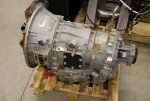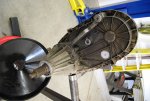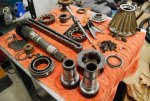onsight512
New member
impressive stuff.
impressive stuff.






The other custom work necessary is to fit the output shaft speed sensor into the t-case output shaft housing and make an adapter ring because the mounting holes (t-case to trans) are way off.
When you convert the Allison tailshaft housing to the 4x4 unit, you lose the sensor provision so I need to do two things to the t-case... 1) machine a tone ring that will fit the output shaft of the t-case and have the right tooth count. This would be super easy if it weren't for the shape of the output shaft. I have a plan for what to do but of course it will require custom machined parts which = $. 2) The housing needs to be machined to accept the sensor. It is pretty important to get the sensor positioned precisely too so that won't be as simple as just drilling a hole.
.
fun stuff!! :a1:
My wife tries to get the terminology straight but most of the time she is WAY off. I had a good laugh about her facebook post.Nice work on the transfer "kit"... :sombrero:
Are there any special tools required for the NV271 rebuild? I have looked for instructions but cannot find anything online.
